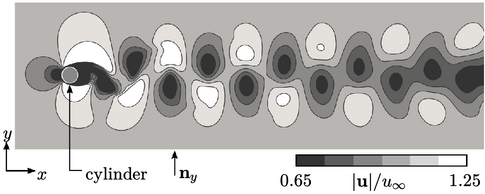8.4 Flow around a cylinder
Flow around a cylinder was used as an example of boundary layer separation in Sec. 6.5 . It showed an image of vortices shedding from the cylinder in a periodic manner, known as the Kármán vortex street.
The image comes from a CFD simulation in two
dimensions, representative of a cylinder of infinite axial length,
using the principal parameters: cylinder diameter  ; freestream
velocity
; freestream
velocity  in the
in the  -direction; and, fluid kinematic viscosity
-direction; and, fluid kinematic viscosity  . The
corresponding Reynolds number
. The
corresponding Reynolds number  , which falls within the laminar flow regime.
, which falls within the laminar flow regime.
The computational mesh used in the simulation is
described in Sec. 8.3
. The centre
height of the cells adjacent to the cylinder was  , corresponding to
a calculated
, corresponding to
a calculated  .
.
The simulation used the transient solution
algorithm in Sec. 5.19
, solving for momentum conservation
for an incompressible fluid, with  and constant
and constant
 .
No energy equation was solved and no turbulence modelling was
required since the flow was laminar.
.
No energy equation was solved and no turbulence modelling was
required since the flow was laminar.
The freestream boundary conditions from
Sec. 4.16
were applied to  and
and
 over the entire external boundary, with reference values
over the entire external boundary, with reference values
 ,
,
 and
and  . The no-slip condition,
. The no-slip condition,  and
and  , was applied on
the cylinder boundary.
, was applied on
the cylinder boundary.
The simulation ran for  with a time step
with a time step
 using recommended numerical schemes from Sec. 3.23
. Oscillations began
in the wake of the cylinder at
using recommended numerical schemes from Sec. 3.23
. Oscillations began
in the wake of the cylinder at  , soon leading to
shedding of vortices which reached a stable pattern at
, soon leading to
shedding of vortices which reached a stable pattern at  .
.
The following figure, shaded by  , shows the
slower-moving vortices as the darker structures which propagate
downstream of the cylinder.
, shows the
slower-moving vortices as the darker structures which propagate
downstream of the cylinder.

The repeated vortex shedding causes
oscillations in the force  of the fluid
on the cylinder. The force
is calculated as the sum of viscous and pressure forces acting on
the cylinder patch faces (
of the fluid
on the cylinder. The force
is calculated as the sum of viscous and pressure forces acting on
the cylinder patch faces ( ), in kinematic units
), in kinematic units  (from kinematic
(from kinematic
 and
and  ) by
) by
 |
(8.1) |
 is shown below,
calculated from: the
is shown below,
calculated from: the  -component of the force is
-component of the force is  , where
, where  is the unit vector
in the
is the unit vector
in the  -direction; and, the projected frontal area
-direction; and, the projected frontal area  of the cylinder.
of the cylinder.

The oscillation period  corresponds to a
Strouhal number
corresponds to a
Strouhal number
 ,
consistent with published data.1
,
consistent with published data.1

